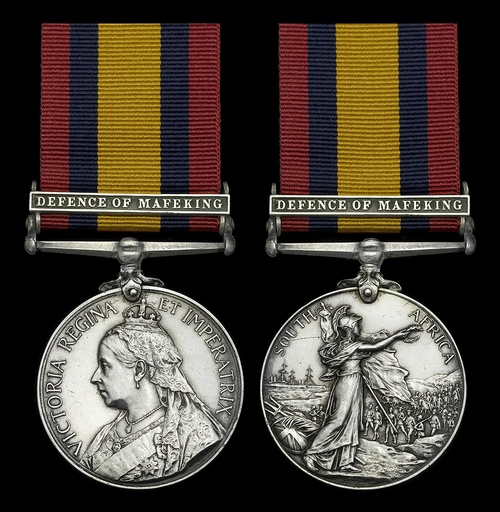
Auction: 24003 - Orders, Decorations and Medals
Lot: 60
The remarkable Queen's South Africa Medal awarded to Corporal Shoeing-Smith H. G. Burt, 17th Lancers attached Protectorate Regiment Frontier Force, one of three men from his Regiment to be present at the Defence of Mafeking; he was killed in action during the Defence on 27 October 1899
Queen's South Africa 1899-1902, 1 clasp Defence of Mafeking (Corpl: Shg: Sth: H. G. Burt. Protect: Regt F.F.), the number officially erased, otherwise good very fine
Note the medal roll notes the medal was returned and re-issued, presumably having erased the number- which appears on the role as the incorrect 4323- rather than the correct 4327.
3 members of the 17th Lancers served attached to the Protectorate Regiment Frontier Force during the Siege of Mafeking.
Hubert George Smith was serving as a Corporal with the Lancers before being attached to the Protectorate Regiment with the rank of Corporal Shoeing-Smith. The night of Smith's death Captain Charles Flitzclarence led a squadron of the Regiment, with the support of the Natal Police in a night raid, it is described by Major F. D. Ballie, in his Mafeking - A Diary of the Siege:
'27th. Shelling continued, and now, having beaten the enemy in the field, Colonel Baden-Powell resolved to give them a taste of cold steel, accordingly, at 8 p.m. D squadron, fifty-three strong, paraded under Captain Fitzclarence, with two parties of the Cape Police in support. It was a fine dark night, and the squadron moved off with injunctions only to use the bayonet. The two parties of Cape Police moved towards the brickfields, one considerably further east than the other to enfilade the rear of the Boer trenches. The object of the attack was some trenches of Commandant Louw's on our side of the racecourse and to the north of the Malmani road (which runs due east of the town to Malmani). It was a still night, and lying waiting one could hear the order to charge, and then the din began. The first trench was carried with a rush; the Boers lying under tarpaulins did not hear the advance till they were almost on them. Sword and bayonet did their work well, and with the flanking parties firing on the rear trench, and the Boers commencing a heavy fire in all directions and from all quarters, things for a time were very lively indeed. It was estimated that six hundred Boers were in laager, so after giving them a thorough dose of the bayonet, the signal to retire was given by a loud whistle, and carried out in the same cool and orderly manner as the advance. In the meantime a furious fire was being maintained by the Boers all round; the volleys from the Cape Police completed their confusion, and they kept on firing even after the wounded had been dressed and placed in hospital. Something frightened them again about 2 a.m., and they recommenced their fusilade [SIC] at nothing and continued it for about an hour. Our losses were six killed, eleven wounded and two prisoners, including Captain Fitzclarence and Lieutenant Swinburne slightly wounded. We subsequently heard that the Boers lost one hundred -forty killed by the bayonet, and sixty whom they had probably shot themselves in the hideous confusion that reigned in their camp. Captain Fitzclarence used his sword with good effect. The Cape Police, who were under Lieutenant Murray, lost none. The attacking squadron did not fire a shot, but in the rush to the second trench the occupants probably shot their own men in the dark at close range.'
Smith was killed in action on 27 October 1899, one of the two days referenced in Captain Charles Fitzclarence's Victoria Cross citation. His death is apparently referred to specially in The Diary of Miss Ina Cowan: Seven Months of a Lifetime; sold together with copied medal rolls and a casualty roll transcription.
Subject to 20% VAT on Buyer’s Premium. For more information please view Terms and Conditions for Buyers.
Sold for
£2,100
Starting price
£600




